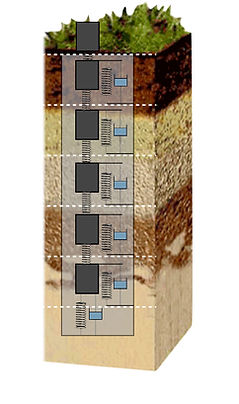Dynamic Pile Testing (PDA Testing):
Dynamic Pile Testing is performed by bolting a set of reusable strain and acceleration sensors to the pile top and collecting the pile top force and velocity readings during each driving hammer impact. The force and velocity readings, collected by the Pile Driving Analyzer® (PDA), are used to evaluate pile integrity and compute the pile driving stresses, hammer transfer energy, and field estimate of pile capacity. Later, in the office, the force and velocity data is analyzed with the Case Pile Wave Analysis Program (CAPWAP®) to give a refined estimate of pile capacity.
The testing is typically performed during initial driving and/or during restrike. Initial drive monitoring is performed to measure and evaluate the pile driving conditions (i.e. driving stresses, hammer transfer energy, pile integrity, and as-driven pile capacity). Restrike testing, after a sufficiently long waiting period, will produce a better estimate of the long-term pile capacity because it will take into consideration the time dependent soil setup and/or relaxation characteristics.
Nagy Engineers will send a qualified and experienced PDA Operator to the site to perform any and all dynamic pile testing. A technician should be provided by the client to count hammer blows per foot and observe and record the pile driving installations.
CAPWAP Signal Matching Analysis:
CAPWAP is a signal matching software that utilizes a similar model to the wave equation. The force and velocity records (obtained in the field during dynamic pile testing) along with the pile material stresswave speed and elastic pile properties are used as program input. The pile capacity, soil resistance distribution along the pile shaft and toe, soil quake and damping factors, and a simulated static load-set curve are the calculated program output.
The basic CAPWAP model is made up of the pile divided into segments of approximately one (1) meter length with equal wave travel time across each segment. By default, every other pile segment is then connected to a soil model segment that consists of an elasto-plastic spring and a dashpot.
Similar to the wave equation, the elasto-plastic spring is loaded until the point when the soil becomes plastic (that point being called the loading quake). In addition to the pile's loading behavior, the unloading quakes are considered in the CAPWAP model, along with the unloading (downward) resistance. The extended model consists of soil plug, radiation damping and/or residual stress analysis.

Wave Equation Analysis (WEAP):
The wave equation is a computer program that simulates pile driving conditions and is a valuable tool for the prediction of pile driving behavior. The analysis is performed, prior to construction/dynamic testing, to assess the proper type and size of pile driving hammer. A Bearing Graph Analysis is primarily utilized for piles that need to be driven to a minimum required capacity, whereas, a Driveability Analysis is utilized for piles that need to be driven to a minimum required depth. On some projects, it may be necessary to perform both analyses.
In wave equation, the pile is divided into segments of approximately one (1) meter length and is modeled as a series of springs (with stiffness) and masses. Each pile segment is then connected to a soil model segment consisting of an elasto-plastic spring and a dashpot. The elasto-plastic spring is loaded linearly versus displacement until it reaches the point at which the soil becomes plastic (this displacement value, when the soil becomes plastic, is called "quake" and is a required input parameter).
While the wave equation is a valuable tool for the prediction of pile driving behavior, the program by itself is not intended to be used to establish pile driving criteria. We have seen several instances where the actual pile driving conditions (i.e. driving stresses, hammer transfer energy, pile capacity, etc.), measured by the PDA, have been significantly different than what has been predicted by WEAP. For that reason, we always recommend that Pile Driving Analyzer® (PDA) testing be performed, on every job, to measure and evaluate the actual pile driving conditions. A Refined Wave Equation, based on the measurements, can be performed after the PDA testing is complete.









